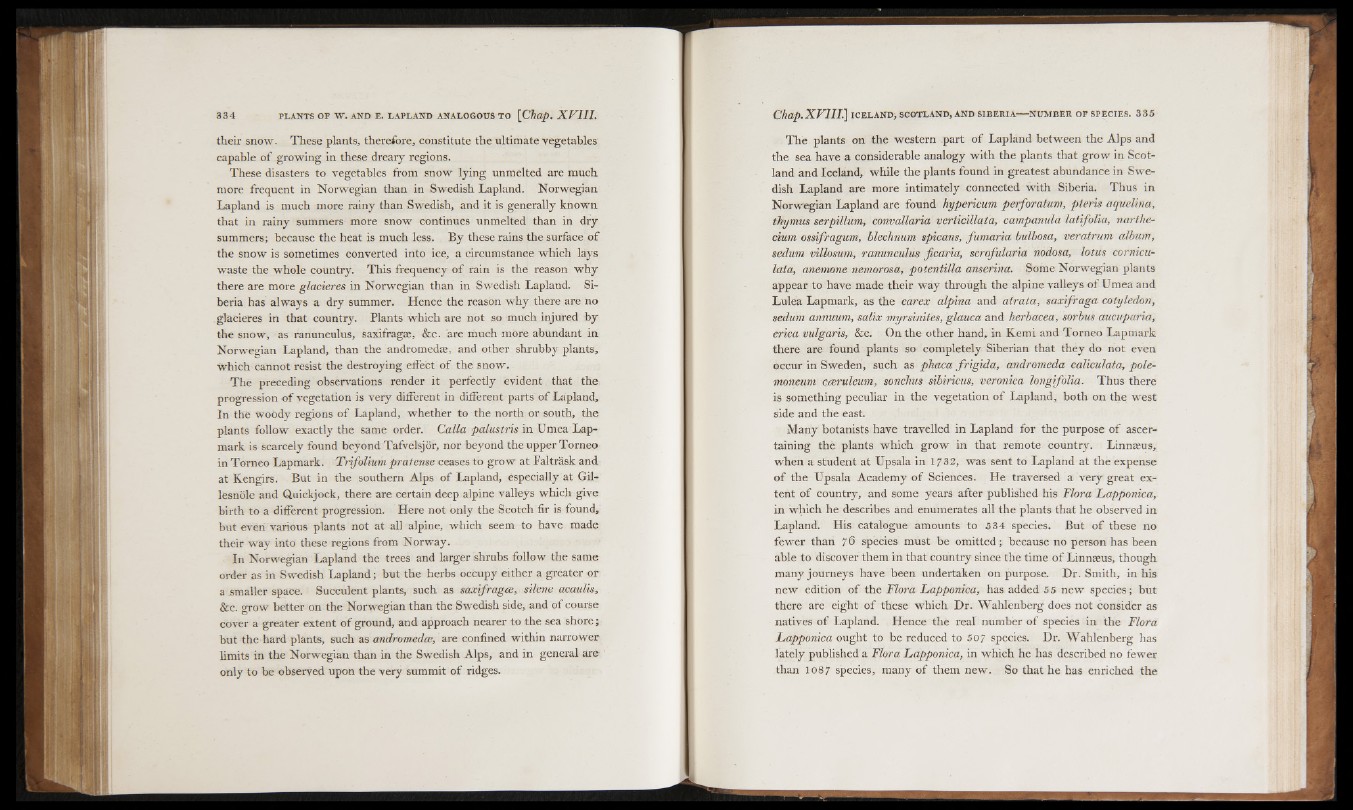
their snow. These plants, therefore, constitute the ultimate vegetables
capable of growing in these dreary regions.
These disasters to vegetables from snow lying unmelted are much
more frequent in Norwegian than in Swedish Lapland. Norwegian
Lapland is much more rainy than Swedish, and it is generally known
that in rainy summers more snow continues unmelted than in dry
summers; because the heat is much less. By these rains the surface of
the snow is sometimes converted into ice, a circumstance which lays
waste the whole country. This frequency of rain is the reason why
there are more glacieres in Norwegian than in Swedish Lapland. Siberia
has always a dry summer. Hence the reason why there are no
glacieres in that country. Plants which are not so much injured by
the snow, as ranunculus, saxifragae, &c. are much more abundant in
Norwegian Lapland, than the andromedae, and other shrubby plants,
which cannot resist the destroying effect of the snow.
The preceding observations render it perfectly evident that the
progression o f vegetation is very different in different parts of Lapland,
In the Woody regions of Lapland, whether to the north or south, the
plants follow exactly the same order. Calla palustris in Umea Lap-
mark is scarcely found beyond Tafvelsjor, nor beyond the upper Torneo
in Torneo Lapmark. Trifolium pratense ceases to grow at Faltrask and
at Kengirs. But in the southern Alps of Lapland, especially at Gil-
lesnole and Quickjock, there are certain deep alpine valleys which give
birth to a different progression. Here not only the Scotch fir is found,
but even various plants not at all alpine, which seem to have made
their way into these regions from Norway.
In Norwegian Lapland the trees and larger shrubs follow the same
order as in Swedish Lapland; but the herbs occupy either a greater of
a smaller space. Succulent plants, such as saxifrages, silene acaulis,
&c. grow better on the Norwegian than the Swedish side, and of course
cover a greater extent of ground, and approach nearer to the sea shore;
but the hard plants, such as andromedae, are confined within narrower
limits in the Norwegian than in the Swedish Alps, and in general are
only to be observed upon the very summit of ridges.
The plants on the western .part o f Lapland between the Alps and
the sea have a considerable analogy with the plants that grow in Scotland
and Iceland, while the plants found in greatest abundance in Swedish
Lapland are more intimately connected with Siberia. Thus in
Norwegian Lapland are found hypericum perforatum, pteris aquelina,
thymus serpillum, convallaria verticillata, campanula latifolia, narthe-
cium ossifragum, blechnum spicans, fumaria bulbosa, veratrum album,
sedum villosum, ranunculus Jicaria, scrofularia nodosa, lotus cornicu-
lata, anemone nemorosa, potentilla anserina. Some Norwegian plants
appear to have made their way through the alpine valleys of Umea and
Lulea Lapmark, as the carex alpina and atraía, saxífraga cotyledon,
sedum annuum, salix myrsinites, glauca and herbácea, sorbus aucuparia,
erica vulgaris, &c. On the other hand, in Kemi and Torneo Lapmark
there are found plants so completely Siberian that they do not even
occur in Sweden, such as phaca frigida, andromeda caliculata, pole-
moneum cceruleum, sonchus sibiricus, veronica longifolia. Thus there
is something peculiar in the vegetation of Lapland, both on the west
side and the east.
Many botanists have travelled in Lapland for the purpose o f ascertaining
thè plants which grow in that remote country. Linna;us,
when a student at Upsala in 1732, was sent to Lapland at the expense
o f the Upsala Academy of Sciences. He traversed a very great extent
of country, and some years after published his Flora Lapponica,
in Which he describes and enumerates all the plants that he observed in
Lapland. His catalogue amounts to 534 species. But o f these no
fewer than 76 species must be omitted ; because no person has been
able to discover them in that country since the time of Linnaeus, though
many journeys have been undertaken on purpose. Dr. Smith, in his
new edition o f the Flora Lapponica, has added 55 new species; but
there are eight of these which Dr. Wahlenberg does not consider as
natives of Lapland. Hence the real number of species in the Flora
Lapponica ought to be reduced to 507 species. Dr. Wahlenberg has
lately published a Flora Lapponica, in which he has described no fewer
than 1087 species, many of them new. So that he has enriched the